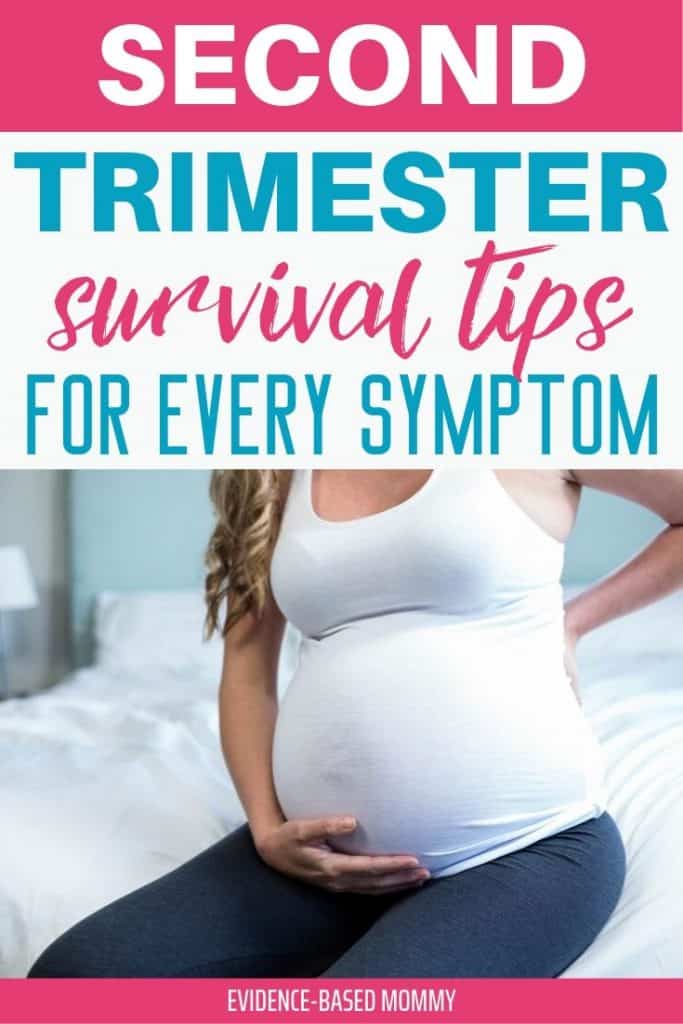Congratulations – you’ve made it to the second trimester of pregnancy. Hopefully, you’ll be feeling better than you did during the first trimester. But if you are still sick in the second trimester or if you are having aches and pains with your pregnancy, you’re not alone.
You’ll often hear of the second trimester being referred to as the “honeymoon phase” of pregnancy. This middle phase of pregnancy (from 14-27 weeks) is hopefully easier for you, but for some expecting moms, it doesn’t really feel any better than the first trimester.
NOTE: I am not a medical doctor. I do, however, have a PhD in Chemistry with a focus in exposure science. That means that I have a lot of expertise in how chemicals (including medicines) get into and affect the human body, and I am especially interested in how chemicals and medicines affect pregnant/breastfeeding women and their babies. Check with your doctor on any medical advice specific to your situation.
Regardless, there are definitely new changes to consider in the second trimester. From back pain during pregnancy to sleeping difficulties, learn all you need to know about making the second trimester as comfortable as possible.
Table of Contents
Surviving second trimester pain and discomfort
For some people, the second trimester is easy. You feel good, you’re over any previous nausea, your belly isn’t so big that it’s making you uncomfortable yet…
Disclosure: This article contains affiliate links. As an Amazon associate I earn from qualifying purchases. You can read my full policy here.
And then there’s the rest of us.
I often still deal with nausea during my second trimester (I’m dealing with it right now with my fourth), plus I have a whole new host of pregnancy symptoms to deal with!
In this post, I’ve tried to catalogue every second trimester discomfort I’ve dealt with so you’ll know how to handle each of them.
Back pain during pregnancy
Some people don’t have problems with back pain until their third trimester (if ever), while others begin having it pretty early on (side note: the more pregnancies you’ve experienced, the more quickly you are likely to experience this).

Even if you’re not having problems with back pain yet, prevention is key! With my second child, I eventually was in tears at just how much back pain I dealt with from simply walking around at work. But with my third, I felt much better. I had learned simple tips to help me take care of my body, and it paid off.
Bottom line: take care of yourself now so you’re not completely miserable by your third trimester.
First, invest in a pregnancy support belt. Not exactly the sexiest undergarment you’ll ever own, but it helps your back throughout the day.
Second, find the exercise that works for you and keeps your body strong. For me, it was finding a yoga teacher who is certified in prenatal yoga. After a relationship over a few years, she knows my body (such as my problems with diastasis recti) and can recommend specific poses for me to try and others to avoid to keep me safe.
Third, I’ve found my chiropractor very beneficial. I only see him every 3-4 weeks, but he gives me tips on how to keep my spine aligned and which exercises and stretches to do to keep my pelvis and core strong. A strong core is able to hold up the weight of that growing belly while protecting your back!
(Note: I’ve also dealt with a very bad chiropractor, who was not medically sound and seemed to keep people trapped by misinformation. Just like any other medical practitioner, pick someone who respects you, and who is there to help you get better and willing to eventually let you go, not someone who wants to see you as often as possible just to get your copayment).
Heartburn during pregnancy
Along with continued nausea during pregnancy comes heartburn! This digestive problem is common among pregnant women.
Basically, your body produces a hormone called relaxin that loosens up your pelvic joints in preparation for your upcoming labor. Unfortunately, some of that relaxin also affects the valve between your stomach and your esophagus, so stomach acid can travel up your throat. Hence, heartburn.

There are things you can do to lessen your heartburn! For one, you’ll learn pretty quickly what foods and drinks bring it on (for me, it’s some usual suspects like orange juice as well as some more strange foods like fried rice). Just don’t eat those foods until after baby is born.
Smaller, more frequent meals will also help manage heartburn and nausea during pregnancy. It might take some habit changes, but it’s worth it to feel better.
Staying upright, especially after a meal, can also prevent heartburn. If you really feel like you need to lie down (because, you know, you’re pregnant), just make sure you stay propped up a bit so that your head/chest is above your stomach.
In addition, a prebiotic supplement can fight against pregnancy constipation, heartburn, and other digestive issues. This one is designed specifically for pregnancy (note: you may feel a little more gassy for one or two days before the prebiotic helps. That’s just your gut adjusting to the prebiotics).
Hopefully, with management of what you eat (and when), you can avoid heartburn without having to turn to medication. But if it’s something that you’re really struggling with, don’t be afraid to ask your doctor which drugs are safe for you and baby.
Breast changes and soreness
With my first pregnancy, I remember waking up one morning and thinking, “My boobs are bigger.” And they were!

Most women have breast growth during pregnancy, and it often happens suddenly around the beginning of the second trimester. In addition, your aereola (the dark area around your nipple) is likely to get larger and darker, and your breasts might be sore.
You’re going to need a few new bras. And because your breasts will continue to change size (they’ll probably go up another cup size a few days after birth), you want to get something that has some stretch, like these.
Note: Your band size will likely go up too! My rib cage seemed to expand some to accommodate baby. Another reason that I recommend these bras is that they come with bra extenders for when the band gets tight.
By the middle to end of your second trimester, you may get some weird crusty stuff on your nipple (I know, TMI. But someone has to tell you. You’re welcome). It’s likely to be pale yellowish, and kind of hard to pick out.
That crust on your nipple is actually a good sign! It means that your body is starting to make colostrum, the first food for baby that is often referred to as “liquid gold.” The dried colostrum isn’t hurting anything, so you can try to remove it if you want, but if it’s difficult, don’t be worried about leaving it there.
Nausea during the second trimester
When I threw up during my fourteenth week of pregnancy, I was mad (but mostly miserable). Wasn’t I supposed to be past feeling this way by now?

Well, maybe. Some people leave behind the nausea when the first trimester ends, while others throw up every single day of their pregnancy. And how you feel in one pregnancy doesn’t dictate how you’ll do in the next one.
RELATED: 7 tips to survive the first trimester
But I’ll give the same advice I give for nausea during the first trimester: Don’t let yourself get too hungry. If you try to wait until a certain time to eat and you’re already hungry, you’ll likely just get sick and feel worse than if you just ate a little when you first felt hungry.
And make sure you go for protein. I know crackers and toast are often more palatable, but protein is what will actually make you feel better (I’ve finally learned this the hard way over the course of four pregnancies). If you have to, eat some toast first and then opt for a cheese stick or bit of chicken, but don’t try to make do on just empty carbs. You’ll just get sicker (I promise).
Generally, your body will let you know when and how much you need to eat. There will be days that you eat a ton, and others where really just don’t want food. Don’t worry about things like calorie counts or how much weight you gain.
What you do want to pay attention to, though, is the types of food that you eat. You need to make sure you’re getting nutrients like folate, iron, and healthy fats.
In fact, what you eat during pregnancy affects your baby’s epigenetics, or which genes are turned “on” or “off.” What you eat now affects your baby’s lifetime risk of diabetes, cardiovascular disease, and more.
If you want more info on nutrition and gene expression, you can learn more with the Perfect Pregnancy Plan.
And if you’re really struggling with nausea? Doxylamine (the blue pill version of Unisom) and vitamin B6 are a proven combination to help specifically with pregnancy nausea (Obviously, check with your physician first). I find that a half to a quarter of a Unisom pill a night is enough to keep my nausea in check so that I can wrangle job and my three kids under seven throughout the day.
How to sleep in the second trimester
You may be less exhausted than in your first trimester, but that doesn’t mean sleep will come easy during pregnancy. Between hormonal changes and the ever-shrinking real estate for your bladder, there will be things waking you up at least a few times a night.
Make life easier for yourself and start going to bed a bit earlier than normal. That way, when you wake up twice to pee and once with a wicked leg cramp, you’ll still have enough time to get enough sleep in-between.
Sore hips at night from pregnancy
Other than nausea, this might be my least favorite pregnancy symptom.
Sometime in your second trimester (maybe your third if this is your first pregnancy), sleeping will go something like this:
- Lie on your left side because that’s what the experts say to do. Eventually fall asleep.
- Wake up with your left hip hurting. Roll over and fall back asleep on your right side.
- Wake up with your right hip killing you. Roll to your left side once more and fall asleep (go pee first).
- Repeat until morning.
It’s not pleasant. Not only do you lose out on a lot of sleep this way, but you also suffer from sore hips!
While I haven’t been able to 100% fix this problem (even after four chances), I have learned how to at least minimize it.
First of all, a pregnancy pillow is an absolute must. Don’t keep telling yourself you’ll wait until you can’t take it anymore; this is an investment you need to make. Go ahead and get the pillow. You’ll thank yourself a million times (promise).
Once you have the pregnancy pillow, make sure you use it correctly. Actually, the woman in the picture above doesn’t have it quite right. See how her feet are hanging off the pillow? That’s going to cause alignment issues.
When you use a pregnancy pillow, make sure both your knee and foot are propped up by the pillow. It’s a tiny change, but it has made a huge difference in my comfort (and has only taken me four pregnancies to figure it out!).
Next, make sure your shoulders are well aligned too. Don’t curl up so that your shoulders are pressed into each other and/or your chest is compressed. Instead, either stay leaned back into the pillow (as the woman in the picture) or prop your arm on the pillow so you don’t lean forward. This second tweak gave me more comfort throughout the night as well.
In fact, I think I only remember rolling over once last night. I do know I woke up amazed that I had stayed asleep through the night as well as I did. I hope these tips work for you too!
Leg cramps at night during pregnancy
While leg cramps can strike a pregnant woman at any time of day, they’re more likely at night. They can be due to a combination of factors, from circulation changes to dips in calcium or magnesium in the body, but regardless, they’re painful!
One of the best ways to avoid leg cramps is to keep up with your prenatal vitamin. This will ensure that you have enough calcium to keep you going (this brand has a decent calcium content that should be well absorbed by the body).
In addition, staying hydrated can help you avoid leg cramps. Sure, you’ll have to get up to go to the bathroom more often, but it’s worth it!
After four pregnancies, I’ve learned there are only certain ways that I can stretch my leg without making it cramp. It’s hard to describe, but (carefully) play with how you stretch your leg. If you start to feel a cramp, back out of that stretch and try something else.
Restless leg syndrome during pregnancy
Another common pregnancy annoyance is restless leg syndrome. It’s hard to describe RLS if it hasn’t happened to you, but your legs feel twitchy or tingly or just weird, and moving them makes it feel better.
So you end up staying awake for a long time just moving your legs. It is absolutely maddening.

But again, there are ways to prevent RLS in pregnancy. First of all, try to get some exercise in each day. For some reason, moving around during the day makes me less likely to get restless legs at night. In addition, staying up reading or watching TV for a long time right before bed seems to set me up for restless legs.
In addition, keep up with those calcium and magnesium supplements! These two minerals are important in nerve function, and I can tell when I’ve been slack on taking my magnesium because I’ll end up with restless legs (choose a chelated magnesium supplement like this one so that it is actually absorbed by the body. And don’t worry, magnesium supplementation is safe during pregnancy).
If you do lie awake one night with restless legs? There’s a few tricks you can try! Get up and massage your calves (if you can reach them!). That will help a little. In addition, some very gentle yoga (such as cat/cow stretches or coming into and out of a modified child pose) can help.

A modified version of legs up the wall, where you prop up your torso a bit, can really relax you and help calm the nerves in your legs as well (this site has excellent pictures of how to do legs up the wall while pregnant). Giving yourself a few minutes in this pose might do the trick!
Conclusions on surviving the second trimester
I know, this post has focused on the aspects of pregnancy that are less than fun, but there’s lots of joy to be found in the second trimester too.
You’ll get to do the 20-week ultrasound (and if you want, find out the baby’s sex), you get to start showing off that baby bump if you haven’t already, and everything will likely start to feel much more real.
Plus, you’ll be ready for making your registry. Make sure to check out my post on everything you need for a non-toxic baby registry.
I hope the survival tips in this post make your second trimester more enjoyable. If there’s any symptoms that I missed and you want to know more about, be sure to ask in the comments. Happy pregnancy!




